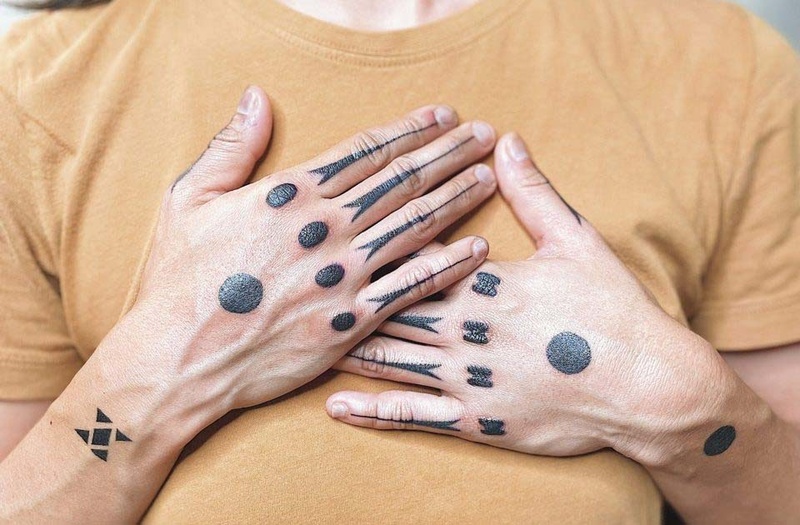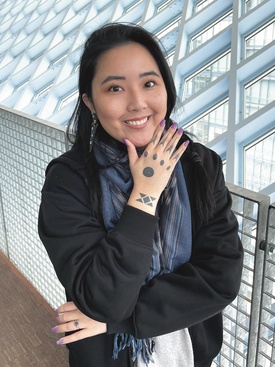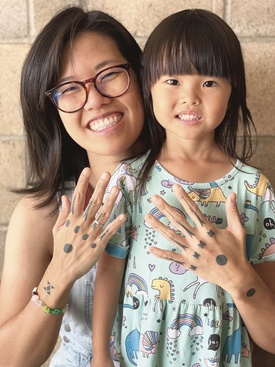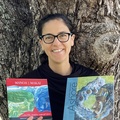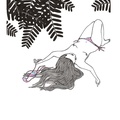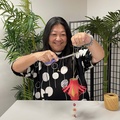My great grandma who wuz born in Okinawa in 1885 had traditional Okinawan hand tattoos known as hajichi. Esteemed Okinawan cultural expert, Eric Wada of da eju-ma-cational group Ukwanshin Kabudan wen do field research on what motivated Okinawan women for get their hajichi.
Wada Shinshï (teacher) shares “hajichi was around and in use from pre-contact times so there is no written documentation of exactly when and how it started, however through oral and documented information, it evolved into a woman’s right of passage to adulthood and had many other spiritual connections, such as genealogy, cosmology and social status.”
Growing up my great grandma felt ashamed of her tattoos cuz in Okinawa, Okinawans wuz coming for be made for feel ashamed of everyting Okinawan. When she came Hawai‘i to work plantation, my great grandma wuz so self-conscious that she made my grandma promise that when she ma-ke time, she wanted to be put in da casket with gloves on.
But how could something that wuz once one mark of great cultural pride transform into one mark of shame? Wada Shinshï explains, “hajichi was banned and discouraged after the illegal annexation and overthrow of the Ryükyü Kingdom in 1879, which resulted in implementation of assimilation programs by the Japanese government, which brainwashed the native people to be ashamed of their ‘savage’ cultural practices and assimilate to the modern and ‘civilized’ Japanese culture.”
For da past several decades dis art form for Okinawan women had been dying out to da point where I noticed that most of my younger friends in Okinawa had nevah even seen hajichi before. Das how rare it wuz.
Interestingly, in da past couple few years seems like get one revival going on. Wada Shinshï shares his mana‘o on dis phenomenon:
“I am happily cautious about the hajichi resurgence and optimistic because things that have been put to sleep can come back. There will be individuals who just want to do it as a fad or without such deep connections, and that is their choice, but for the most part, I see more interest in reviving the tradition connected to the deeper spirituality and identity.”
Below get tree young Local Uchinänchu women and their hajichi stories.
* * * * *
SARAH TAMASHIRO KUAIWA
Sarah stay from Waimalu and is one St. Andrews Priory grad. She currently da curator for Hawai‘i and Pacific Cultural Resources at da Bishop Museum. Though not ethnically Okinawan, her adoptive faddah stay Okinawan — their Tamashiro side stay from Kitanakagusuku and their Higa side stay from Isshado, Nakagusuku. Her hand tattoos incorporate Okinawan and Hawaiian elements.
When wuz da first time you saw or heard about hajichi?
I first heard about hajichi after reading a book that included an illustration and description of a woman’s hajichi. I had never heard of Okinawan tattooing traditions before. To my surprise, my family had a lot to say. It was striking and very moving to learn that hajichi was still held within the memory of my family.
What made you decide for get one creative non-traditional hajichi?
I had the privilege of learning a lot about Hawaiian tattooing (käkau uhi) through friends and colleagues. One of my mentors had her hand tattooed and she explained how it related to her work and her family. After I learned about hajichi, I talked to my friend, who was a tattoo apprentice under Hawaiian tattoo practitioner Keli‘i Mäkua and he joked that we should tattoo my hand.
Around the same time, I had gotten into a Ph.D. program that I had applied to in Europe. My purpose felt very solidified and I wanted to mark my pursuit in education as a commitment to myself, my family, and my community.
Your hand tattoos get some Hawaiian elements too. You Hawaiian?
I am Hawaiian and very proud of it. Keli‘i Mäkua decided on the designs and placement.
You can try explain da symbols on top your hands and what dey mean?
My right hand talks about my ancestors and navigating home. My left hand talks about the pursuit of knowledge, which is in alignment with my career.
Try explain how come you no like your full hands be in da photo for dis article.
I’ve actually had people copy the designs on my hands. I was scrolling Instagram one day and saw my hands on someone else’s hands! It was so strange, especially since the designs and their placement were made custom to fit me and my purpose. This has happened a few times actually over the five years that I’ve had them. Indigenous tattoo design stealing has been a frequent topic among indigenous tattoo practitioners. I don’t necessarily hide my hands from photos, but I also don’t go out of my way to have attention brought to them.
RACHEL MIYAZAKI
Rachel stay half Okinawan on her mom’s side. She’s one ‘Aiea class of 2009 grad who stay one operations associate in Seattle but she hoping for move back Hawai‘i soon. In 2019 Rachel decided for get hajichi on one hand.
How come you got your hajichi?
Growing up, my mom would share tidbits about her parents, grandparents and uncles here and there, and I have just a few photos of them. So getting my hajichi was a way for me to fill the void I felt of not getting to know my Okinawan side of my family.
How you chose your design?
My mom told me that her grandmother had hajichi. She doesn’t remember the designs, and we don’t have any photos of my great grandmother. I researched patterns from different areas and decided on the Naha style, since it was closest to where my family is from.
You can try tell what da symbols mean?
Right now, I just have my right hand done. There are differing perspectives on the meaning of the symbols. Some believe the arrowhead shapes represent entering paradise, meeting your ancestors in paradise, or women leaving their families after marriage. I have read the circle shapes represent a winding thread and the square-like shapes represent a sewing box, since sewing was an important skill back then. I have also heard the square-like shapes represent a type of shellfish. I think while the practice of hajichi is starting to have a revival, there is still a lot of gray area in understanding the meanings of the symbols and the tattoos themselves.
How you got ‘em for free?
I received my tattoo from Jun Osaki, a Japanese American tattoo artist who was offering to do hajichi on one hand for folks of Okinawan descent as reparations. Jun has offered this free service to myself and other folks of Ryükyüan descent as a way to make amends for the harms caused by and lasting impacts of Japanese colonization.
MISTEE UYEHARA
Mistee stay three-fourths Okinawan. She’s one ‘Aiea class of 2003 grad who’s currently one farmer and artist living in ‘Aiea. In 2023 she went all da way to Okinawa for get her hand-poke hajichi.
What made you decide for get your hajichi?
I remember seeing them featured at the Okinawan Festivals here in Honolulu and discovering more information online about hajichi, especially in recent years. I was, and forever am, in complete awe learning about the history, meaning and strength behind this traditional practice and how it is specifically for Ryükyü/Okinawan women. It definitely lit that spark into my personal hajichi journey.
How you chose your design?
With the help of Hajichiä Moeko Heshiki’s research and also discovering that my great grandparents were both from Ishikawa Iha, that’s how I knew I wanted to receive hajichi with the symbols that were commonly found on the main island of Okinawa.
You can try tell what da symbols mean?
Moeko explained to me that the circular designs found on the center of both hands are called Marubushi or “round star.” The circle on my left wrist is called Aman meaning “hermit crab.” In Ryükyü, the ancient times are called “Aman World” and it’s believed humans were born from Aman. The pattern on my right wrist is called Ichichibushi or “five-star.” It symbolizes going to paradise. The design on my fingers and thumbs is called Yainusachi. It’s said if you have these, you can meet our ancestors in paradise. The designs on my left and right knuckles are types of shellfish and she said the meanings for these are unknown.
You want your daughter for have hajichi one day too?
I think my wants and hopes for Mai would be to learn, love and embrace who she is and that is definitely possible with or without having hajichi. With that said, before leaving for my trip to Okinawa, I read your “Okinawan Princess” book often for bedtime leading up to my trip to let Mai know mommy is planning to get tattoos like the princess in the book. I asked her what she thought and held my breath. To my surprise she replied, “Can you ask if babies can get hajichi, too?” My heart felt warm. She currently says she wants to get them too, so we can be “twinsies.” She’s just 4.5 years old, mind you.
*This article was originally published in The Hawai'i Herald on August 18, 2023.
© 2023 Lee A. Tanouchi


